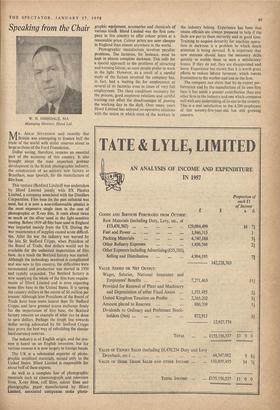Speaking from the Chair
W. H. DIMSDALE, MA Managing Director, Ilford Dd.
MR. ADLAI STEVENSON said recently that Britain was attempting to finance half the - trade of the world with dollar reserves about as large as those of the Ford Foundation.
Dollar saving, therefore, remains an essential part of the economy of this country. It also brought about the most important postwar development in the British photographic industry, the construction of an entirely new factory at Brantham, near Ipswich, for the manufacture of film base.
This venture (Bexford Limited) was undertaken by Ilford Limited jointly with BX Plastics Limited, a company associated with the Distillers Corporation. Film base (in the past celluloid was used, but it is now a non-inflammable plastic) is the most expensive single item in the cost of photographic or X-ray film. It costs about twice as much as the silver used in the light-sensitive coating. Before 1939 all film base used in England was imported mainly from the US. During the war maintenance of supplies caused acute difficul- ties. After the war the industry was warned by the late Sir Stafford Cripps, when President of the Board of Trade, that dollars would not be available for the unlimited importation of film base. As a result the Bexford factory was started. Although the technology involved is complicated and was new to this country, the difficulties were surmounted and production was started in 1950 and rapidly expanded. The Bexford factory is now supplying the whole of the film base require- ments of Ilford Limited and is even exporting some film base to the United States. It is saving the country dollars to the extent of $6 million per annum. Although later Presidents of the Board of Trade have been more lenient than Sir Stafford Cripps, and have granted scarce exchange freely for the importation of film base, the Rexford factory remains an example of what can be done to save dollars. Perhaps the tough line towards dollar saving advocated by Sir Stafford Cripps may prove the best way of rebuilding the slender hard currency reserves.
The industry is of English origin, and the pro- cess is based on an English invention, but for various reasons it is now largely in foreign hands.
The UK is a substantial exporter of photo- graphic sensitised materials, second only to the United States. Ilford Limited is responsible for about half of these exports.
As well as a complete line of photographic materials such as cinematograph and television filn-ts, X-ray films, roll films, colour films and photographic paper manufactured by Ilford Limited, associated companies make photo- graphic equipment, accessories and chemicals of various kind's. Ilford Limited was the first com- pany in this country to offer colour prints at a reasonable price. Colour prints are now cheaper in England than almost anywhere in the world.
Photographic manufacture involves peculiar problems. The factories, for *instance, must be kept in almost complete darkness. This calls for a special approach to the problems of attracting and training labour, as most people prefer to work in the light. However, as a result of a careful study of the factors involved the company has, in fact, had a waiting list for employment at several of its factories even in times of very full employment. The clean conditions necessary for the process, good employee relations and careful training can offset the disadvantages of passing the working day in the dark. Over many years Ilford Limited' has enjoyed co-operative relations with the union to which most of the workers in the industry belong. Experience has been that union officials are always prepared to help if the facts are put to them correctly and in good time. Training to acquire dexterity for machine opera- tion in darkness is a problem to which much attention is being devoted. It is important that new entrants should learn the necessary skills quickly to enable them to earn a satisfactory bonus. If they do not, they are disappointed and leave. Experience has shown that it is worth great efforts to reduce labour turnover, which means frustration to the worker and loss to the firm.
The company can claim that by its export per- formance and by the manufacture of its own film base it has made a greater contribution than any other firm in the industry and one which compares well with any undertaking of its size in the country. This is a real satisfaction to the 4,500 employees of this seventy-five-year-old but still growing concern.






























 Previous page
Previous page